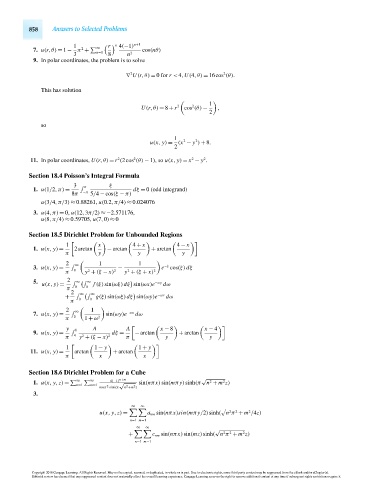Page 878 - Advanced_Engineering_Mathematics o'neil
P. 878
858 Answers to Selected Problems
1 n 4(−1) n+1
r
2
7. u(r,θ) = 1 − π + ∞ cos(nθ)
n=1
3 8 n 2
9. In polar coordinates, the problem is to solve
2
2
∇ U(r,θ) = 0for r < 4,U(4,θ) = 16cos (θ).
This has solution
1
2
U(r,θ) = 8 +r 2 cos (θ) − ,
2
so
1
2
2
u(x, y) = (x − y ) + 8.
2
2
2
2
2
11. In polar coordinates, U(r,θ) =r (2cos (θ) − 1),so u(x, y) = x − y .
Section 18.4 Poisson’s Integral Formula
ξ
π
3
1. u(1/2,π) = dξ = 0 (odd integrand)
8π −π 5/4 − cos(ξ − π)
u(3/4,π/3) ≈ 0.88261, u(0.2,π/4) ≈ 0.024076
3. u(4,π) = 0, u(12,3π/2) ≈−2.571176,
u(8,π/4) ≈ 0.59705, u(7,0) ≈ 0
Section 18.5 Dirichlet Problem for Unbounded Regions
1
4 + x 4 − x
x
1. u(x, y) = 2arctan − arctan + arctan
π y y y
1 1
∞ −ξ
2
3. u(x, y) = − e cos(ξ)dξ
2
π 0 y + (ξ − x) 2 y + (ξ + x) 2
2
5. 2 ∞ ∞ −ωy
u(x, y) = 0 0 f (ξ)sin(ωξ)dξ sin(ωx)e dω
π
∞ ∞ −ωx
2
+ g(ξ)sin(ωξ)dξ sin(ωy)e dω
π 0 0
1
2 ∞
7. u(x, y) = sin(ωy)e −ωx dω
π 0 1 + ω 2
y 8 A A x − 8 x − 4
9. u(x, y) = dξ = −arctan + arctan
π 4 y + (ξ − x) 2 π y y
2
1
1 − y 1 + y
11. u(x, y) = arctan + arctan
π x x
Section 18.6 Dirichlet Problem for a Cube
∞ ∞ 4(−1) n+m √
2
2
1. u(x, y, z) = √ sin(nπx)sin(mπy)sinh(π n + m z)
n=1 m=1
nmπ 2 sinh(π n 2 +m 2 )
3.
∞ ∞
2
2
2
u(x, y, z) = a nm sin(nπx)sin(mπy/2)sinh( n π + m /4z)
n=1 m=1
∞ ∞
√
2
2
2
+ c nm sin(nπx)sin(mz)sinh( n π + m z)
n=1 m=1
Copyright 2010 Cengage Learning. All Rights Reserved. May not be copied, scanned, or duplicated, in whole or in part. Due to electronic rights, some third party content may be suppressed from the eBook and/or eChapter(s).
Editorial review has deemed that any suppressed content does not materially affect the overall learning experience. Cengage Learning reserves the right to remove additional content at any time if subsequent rights restrictions require it.
October 14, 2010 17:50 THM/NEIL Page-858 27410_25_Ans_p801-866

